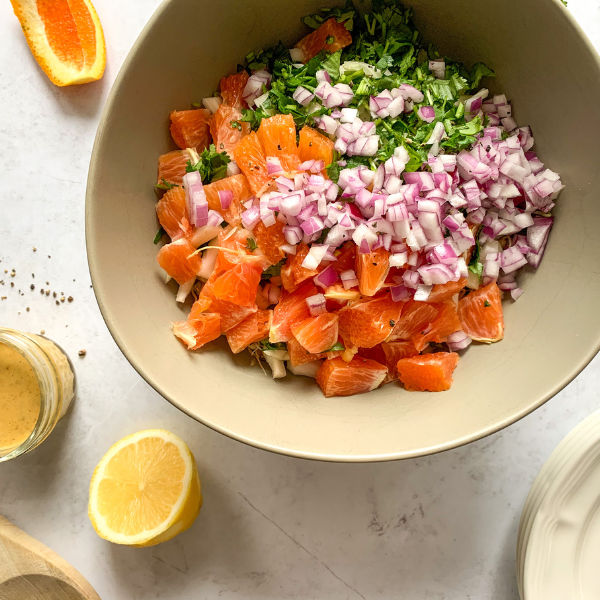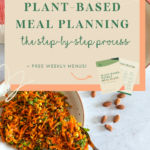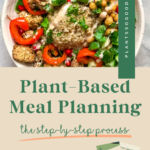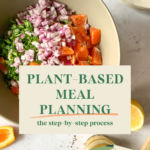Today I’m showing you how to create a weekly meal plan full of delicious plant-based meals. No matter where you are in your health journey right now, if you’re not doing weekly meal planning, you’re making your life more difficult than it needs to be. Keep reading to change that!

Do you love the idea of eating plant-based but never feel organized enough to get started? Have you heard about meal planning but aren’t sure how to do it? Maybe it sounds like a nice thing that “those organized people” do but seems way too time-consuming for your busy life?
I hear you!
Meal planning can seem scary and overwhelming, like just one more thing on your to-do list. Lucky for you, the process I’m about to teach you will save you so much time during the week. I’m sure we could probably all use more of that, right?!
On top of that, sticking to a plant-based diet becomes infinitely easier if you have a meal plan to follow each week!
So today I’m breaking down the exact process of how I create my plant-based meal plan each week. I’ll show you how you can easily create your own weekly plant-based meal plan in just 30 minutes per week and save time, energy, and money!
First, let’s talk about why meal planning is so helpful when trying to eat plant-based.
Why You Should Meal Plan
One of the frustrations I hear a lot from people interested in eating more plants is that they don’t know what to make and are worried plant-based meals will be redundant and boring. And while some people like repeating the same meals on a weekly or bi-weekly basis, I think most of us like variety. Thankfully, eating plants doesn’t mean you have to eat any one type of cuisine or meal.
Just because we’re bombarded with pretty pictures of avocado toast every.single.day online doesn’t mean that a plant-based diet even has to include that!
Meal planning is your ticket to creativity and variety in your weekly meals, and the key to eating plant-based long-term without getting overwhelmed or needing to spend all your time cooking.
Seven reasons to create weekly plant-based meal plans
- Meal plans work for any type of cuisine – literally no limitations here, friends!
- They aren’t limited due to food sensitivities, tastes, or preferences
- They don’t discriminate based on income or grocery budget
- Meal plans can work for everyone!
- They save you money, mental energy, and time each week
- They help you stick to a healthy lifestyle
- And finally, meal plans give you the opportunity to try out new dishes, and never get bored of your meals
Sounds pretty good, right?
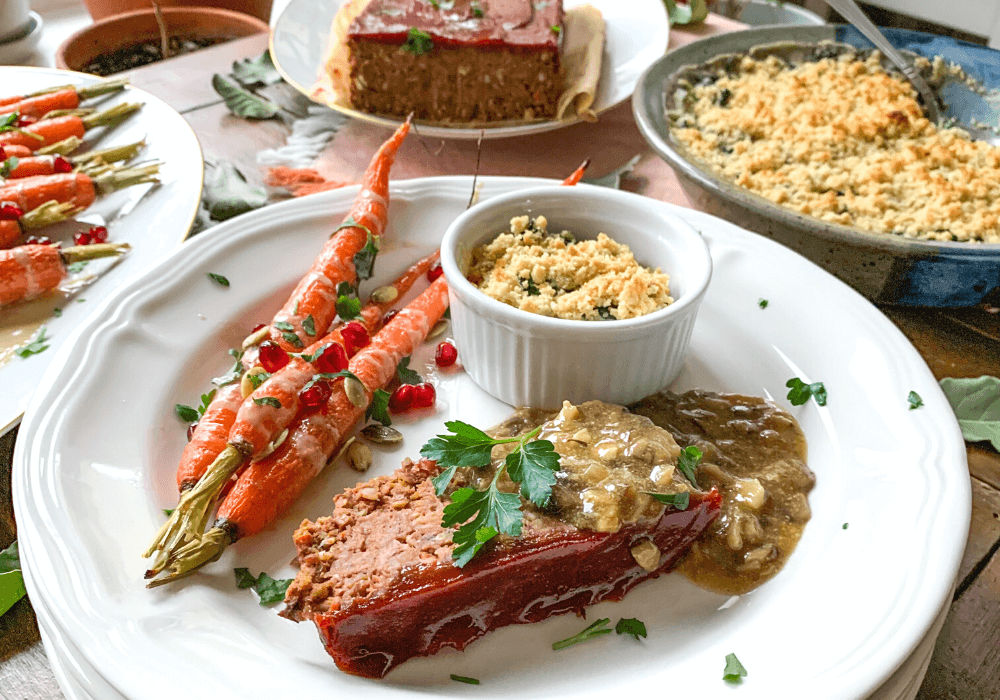
So how can a weekly plant-based meal plan do all that?
Put simply, planning out your meals and making sure you have the ingredients and time to make those meals means you’re setting yourself up for success. Having a list of meals you’re going to make each week and those ingredients sitting in your fridge ready to go means you’re sidestepping one of the biggest downfalls of all healthy eating attempts.
Without a meal plan, you might instead come home from work absolutely STARVING only to look in your fridge, realize you have no ingredients to make a plant-based meal, and at the same time recognize that even if you did, you’d have no idea what to make. By now you’re really hungry and decide to order some takeout. You’ll try eating healthy again tomorrow. Sound familiar?
This scenario is so common! Not only does it mean that eating more plants feels really hard, but it also makes people who experience this feel like they’re “failing at eating healthy”.
In reality, eating a healthy diet and introducing more plants into your daily meals is a process. It doesn’t happen overnight. Some days and weeks you’ll eat much healthier than others. And that’s okay!
Now that I hopefully have you convinced of the powers of meal planning, let’s get into the nitty-gritty of how to actually do the thing!
How to Create a Plant-Based Meal Plan: My Step-by-Step Process
Step 1: Take inventory
Make a list of what you already have. Look in your fridge and pantry and make a mental or physical list of ingredients you have on hand. I like to make this list in the Notes app on my phone, as that’s also where I keep our grocery shopping list and weekly meal plan.
PSG TIP: Try grouping similar types of food together on the list. Put your veggies in one section, all your grains in another, etc. You can also add a second layer of organization to your list by putting the ingredients that need to be used up first at the top of the list and the shelf-stable things at the bottom. Those 3 heads of lettuce? Those should go at the top. That brown rice in your pantry? Down to the bottom with you.
Step 2: Consult your calendar
Look at your calendar for the coming week. Ask yourself: which days are you going to be super busy? Do you have any special meetings or events this week? Maybe as you review your calendar you realize there’s an entire day where you’ll have no time to cook at all. That’s ok! Make a note of it so you can be prepared. You could plan to make a double batch of dinner the day before, plan to eat that day’s lunch out, and make a pot of overnight oats before going to bed the night before.
Are you starting to see how having a plan before the week begins will totally change how that week goes?
Step 3: Gather inspiration
Look through your Pinterest boards, recipe books, or your favorite recipe blogs for inspiration. (Click here to see current PSG recipes, and here for PSG Pinterest boards, where I have a ton of plant-based recipes.) Is there anything you’ve been wanting to make? This is your chance to ensure your meals don’t get repetitive or boring. If you’re worried about redundant meals, try out different cuisines and recipes you’ve never made before! On the other hand, if you have a super busy week coming up and are already feeling overwhelmed, look for quick and easy recipes you’re familiar with.
PSG TIP: Do your best to find recipes that use the items on your “already have & need to use up” list that you created in step 1. Not only is this a great way to save money because your grocery list for the coming week will be shorter, but it’s also a really effective strategy for reducing food waste.
Step 4: Start planning
Time to start putting it all together! Write out each day of the week and note all the meals you need to plan out (ex: if you’re going out to dinner on Friday, you won’t need to plan that dinner).
This is where you can really adapt this system to work for you. I’ve found that I prefer to only plan out our lunches and dinners Monday through Friday. We always eat the same thing for breakfast so there’s no need to plan that out, and I love to go with the flow on the weekends. Do what works for you and your schedule!
Step 5: Organize those recipes
Start filling in each meal that you want to plan out with the recipes you collected in step 3. (ie, add that chili recipe to Tuesday’s dinner, and that kale salad recipe to Thursday’s lunch). Consult your calendar as you fill in the meals to help you determine which day gets which meal. And don’t worry if you use up all the recipes you’ve saved and still have unplanned meals left. We’ll get to that in the next step!
PSG TIP: It can be easy to get stuck in analysis paralysis here, especially when looking at an entire week of blank spaces waiting for recipes. This process gets easier every time you do it. But it might also help to know that if you’re excited about all the recipes you’ve decided to make that week (which you should be!), then aside from calendar conflicts, it really doesn’t matter when you eat what.
Step 6: Fill in the blanks
Once you’ve added all the recipes you selected in step 3, take a look at your remaining empty spots. See which dinners can double as leftovers for lunch the following day. Eating leftovers for lunch is a great time-saver and things like soups, stews, and curries all taste better the next day, so it can be a win-win! Also, take another look at your calendar and make sure meal prep times match how much time you’ll have on a given day to cook. Last, check which ingredients you still need to use up that haven’t made it into any of your planned meals yet and find specific recipes that use those ingredients. (Pinterest is a great tool for this!) Keep working on this step until all the meals you wanted to plan for the coming week are filled in.
Step 7: Make a grocery list
You’ve done the hardest part, now it’s time to ensure your plan doesn’t go to waste! Go through your completed meal plan and add any items you need to buy to your grocery list. Be sure to reference any recipes you plan to use so you don’t forget any ingredients.
PSG TIP: Don’t forget to check pantry staples like olive oil, garlic, and spices. There’s nothing worse than starting to cook a meal only to realize you’re completely out of a key ingredient!
Step 8: Go shopping
You’ve reached the final step in this meal planning process! All that’s left to ensure your meal plan goes off without a hitch is to go get those groceries! Don’t forget your grocery list!
PSG TIP: Since you’ve planned out all your meals, you should feel confident that you only need to buy the ingredients on the list you just made in step 7. If you didn’t plan for snacks or breakfast, make sure you add those ingredients to your list as well before you go to the store.
Ta-da! Your well-thought-out expertly crafted plant-based meal plan is complete!
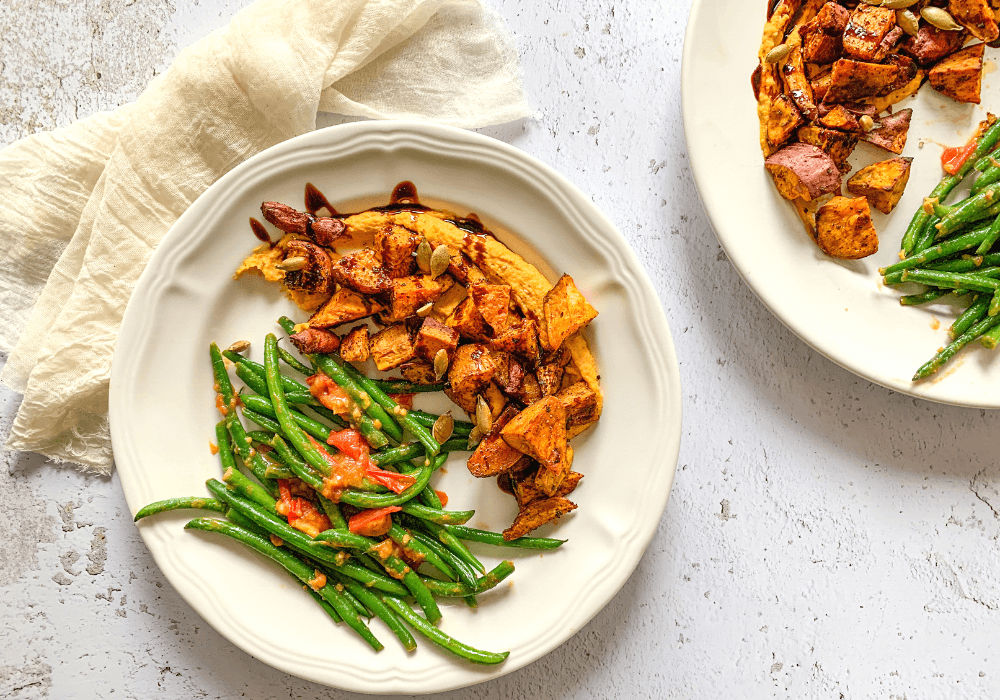
I know this process seems long, but once you do it a few times, steps 1-7 will take you thirty minutes or less, and step 8 (the actual grocery shopping) may take you another 30 minutes or so. Not too shabby, right?
I hope this process helps you build confidence in your ability to eat plant-based on a regular basis. I know that as a busy entrepreneur, meal planning like this has been game-changing and has saved me countless hours during the workweek, money spent on groceries I didn’t need, and mental energy trying to pull plant-based meals together last minute.
If you try out this process, I’d love to hear how it turns out for you! Tag @plantssogood on Instagram or Facebook or send me a DM! And if you have any questions about this process, I’m here for you!
